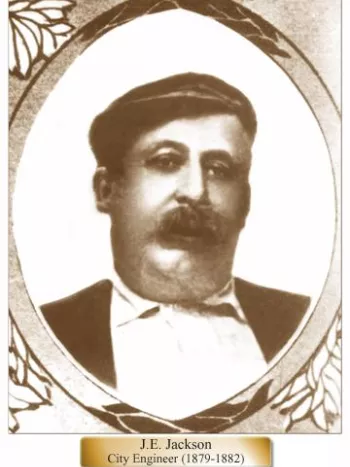
No known biography of Mr. Jackson appears to be available at this time.
City records reflect that he was appointed City Engineer on December 11, 1879, and reappointed December 18, 1880; December 17, 1881; and succeeded by George Hansen on December 18, 1882.
A brief mention is made in Newmark's 60 Years In Southern California which states Mr. Jackson was at one time an agent for the Los Angeles and San Pedro Railroad Company.
Los Angeles chronologies for the period of Mr. Jackson's tenure as Surveyor/Engineer show that in 1879, private citizens donated 308 lots and the University of Southern California was founded. Also, subdivisions of large Mexican and Spanish land grants led to settlement of various communities in Los Angeles County, a population expansion probably involving surveying and probably involving Mr. Jackson's professional efforts directly or indirectly as did the following events.
In 1880, Santa Fe decided Los Angeles rather than San Diego would be its pacific terminus, breaking the transcontinental monopoly of Southern Pacific. This same year the first cement and asphalt pavement in the City was laid on Main Street north of First Street and Los Angeles got its first cement sidewalk. Also the first oil pipeline was laid in Southern California.
In 1881, The California Editorial Association was invited to hold a convention in Southern California in the hopes editors would write of the beauty and benefits of the City to stimulate its growth but when convention time came, snow fell when the editors were meeting "thus causing the booster plan to fail. "
Southern Pacific sold the City land, which became East Lake Park (now Lincoln Park). The jetty at San Pedro was completed, a great step forward to development of a major port there.
The year 1882 was when the Los Angeles Telephone Company, by ordinance, was given the right to erect poles and start telephone service in the City. Brush Electric Lighting Company installed the first streetlights to a wave of citizenry protest (not unlike anti nuclear power protests today). Citizens (joined by the Gas Company) argued street lights were hard on the eyes, produced color blindness, optical illusions, was bad for ladies complexions, kept chickens awake all night, attracted bugs, and that poles would draw lighting. The lights did attract bugs, but so do picnics.